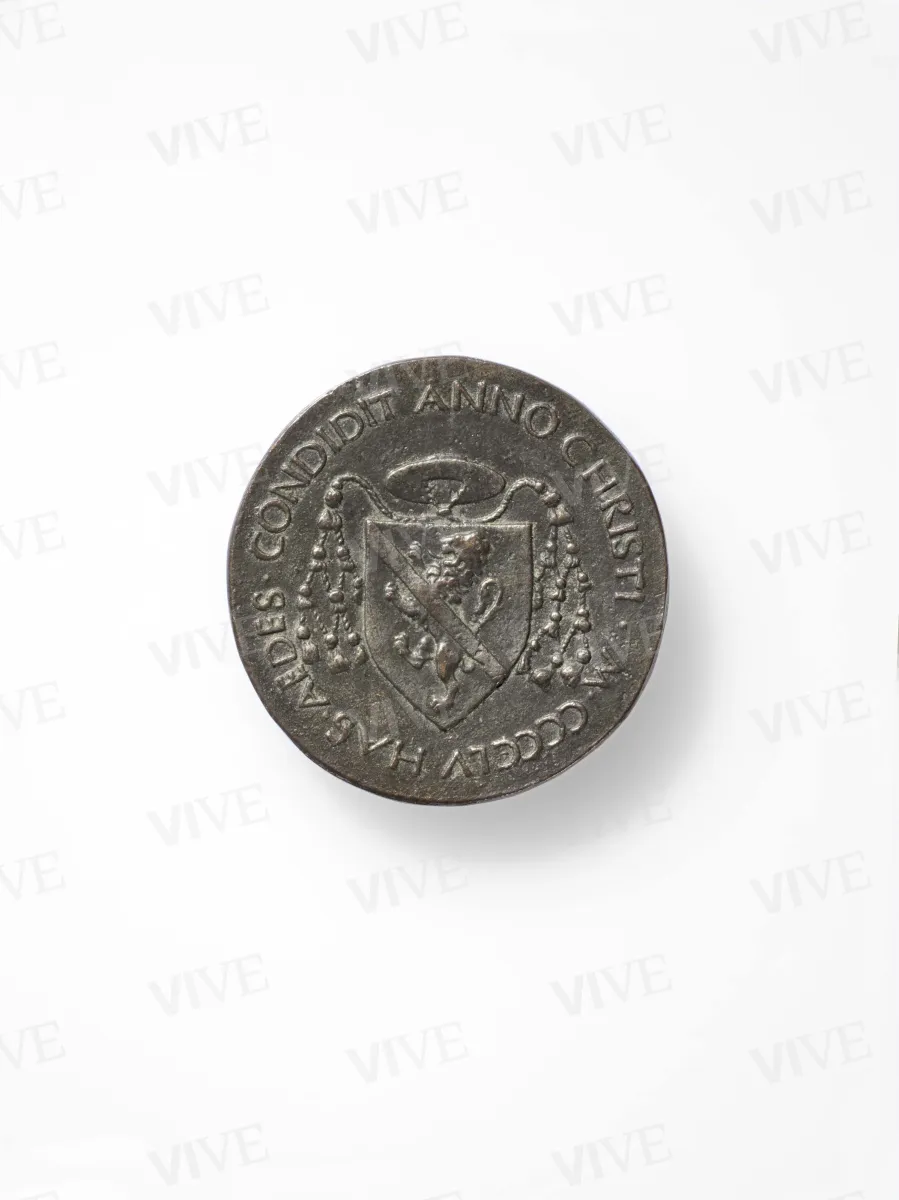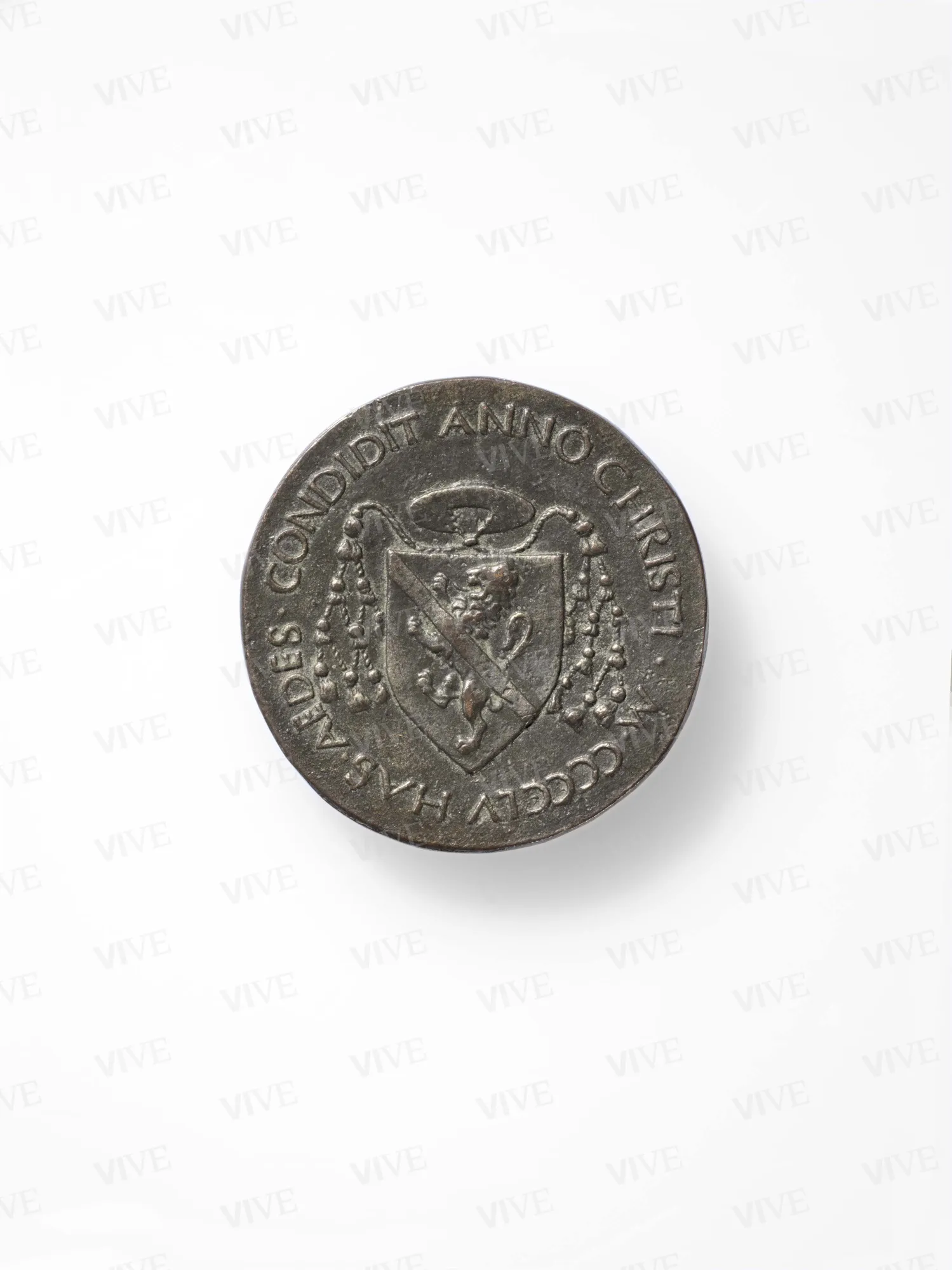Medal with portrait of Cardinal Pietro Barbo/Barbo coat of arms
San Marco workshops 1455
This medal marked the beginning of an extensive series of commissions by Pietro Barbo, who would later ascend to the papacy as Pope Paul II, featuring his own likeness.
The foundation medal, intended to ensure the cardinal's remembrance by future generations, was discovered during restoration work on the Palazzo Venezia between the late nineteenth and early twentieth centuries. Created by a master from the Officine di San Marco workshops that served the cardinal, the medal is dated 1455 and indicates, in the inscription on the reverse side, the commencement of the building's construction.
This medal marked the beginning of an extensive series of commissions by Pietro Barbo, who would later ascend to the papacy as Pope Paul II, featuring his own likeness.
The foundation medal, intended to ensure the cardinal's remembrance by future generations, was discovered during restoration work on the Palazzo Venezia between the late nineteenth and early twentieth centuries. Created by a master from the Officine di San Marco workshops that served the cardinal, the medal is dated 1455 and indicates, in the inscription on the reverse side, the commencement of the building's construction.
Details of work
Catalog entry
Around the figure of Pietro Barbo (1417–1471), particularly after he assumed the papal throne under the name Paul II (1464), a notable assembly of artists began to congregate, specializing in the creation of small-scale art pieces such as engraved stones, jewelry, and primarily metalwork. Within the confines of what is conventionally referred to as the Workshops of the Palazzo di San Marco, also known as Palazzo Venezia, both Roman and external artists were actively involved in casting medals depicting portraits of Barbo and plaques that replicated his collection of engraved gems (Cannata, in Rilievi e placchette 1982, pp. 16–17).
The obverse of the medal features the bust of the cardinal facing left, with his tonsure and stole adorned with floral motifs, secured by an oval button beneath which the pleated alb is visible. The reverse displays the Barbo coat of arms with a lion rampant facing left, crossed by an oblique band, topped by the cardinal’s galero from which ten tassels descend on each side (Hill 1930, I, p. 191, n. 737; Zaccariotto 2020, p. 114, n. 85).
Several specimens of this medal type, along with many others, were discovered in 1876 within the foundations of Palazzo Venezia. They had been buried inside a money box (known as a dindarolo), adhering to a tradition actively supported by Barbo. This practice involved placing objects related to the commissioner in the building's foundations to ensure their memory would be preserved. References include Lanciani (1902, ed. 1989, pp. 68–69) and Balbi De Caro (1971 and 1973).
The documents related to the building indicate that in 1466, the palace administrator allocated funds to purchase one hundred and twenty-nine pots, later also called "pignatis," to place metalwork in the new walls. These funds were renewed in 1470 and up until March 1471, showing a consistent practice during the works on the Palace ordered by the Pope (Weiss 1958, p. 74–75). At least sixteen of these money boxes were recovered during various restoration and consolidation campaigns of the building (1919 and also 1931, in Balbi De Caro 1973), and all contained medals featuring Barbo's profile, both as cardinal and pontiff (inv. 2995 or inv. 2915).
This medallion is the inaugural piece created for Barbo: he is depicted once more as Cardinal of San Marco, a title he assumed on July 1, 1440 (Modigliani 2014). The medallion was produced to commemorate the commencement of construction on his cardinal’s residence, Palazzo Venezia, in 1455, as indicated by the legend on the reverse.
Although the date is well-established, the question of attribution remains unresolved. This medallion type is unsigned and markedly different from those associated with the pontificate of Paul II, attributed to Cristoforo di Geremia (inv. 3169). The bust is small and compact, occupying only the lower part of the disc, while the letters are dry, regular, and unembellished, in contrast to what is observed in later medals.
Despite numerous attributions to the papal medallist Andrea Guazzalotti (Balbi De Caro 1973, pp. 28–29 and Modesti 2002, p. 228), it is more judicious to assert that the medal was produced in the workshops of San Marco. This conclusion is supported by the existence of examples with identical obverses but reverses depicting the design for the façade of the Palazzo. This practice reflects a common technique in medal creation, whereby existing models are utilized to generate new combinations of obverse and reverse designs within the workshops (Hill 1910).
Giulia Zaccariotto
Entry published on 27 March 2025
State of conservation
Good.
Coats of arms, emblems, and marks
Obverse: “PETRVS • BARBVS VENETVS CARDINALIS S[ancti] MARCI”
Reverse: “HAS • AEDES • CONDIDIT ANNO CHRISTI • M • CCCCLV”
Provenance
Palazzo Venezia, foundation money boxes.
References
Hill George Francis, The Medals of Paul II, in «Numismatic Chronicle», s. 4, X, 1910, pp. 340-369;
Hill George Francis, A Corpus of Italian Medals of the Renaissance Before Cellini, 2 voll., London 1930;
Weiss Roberto, Un umanista veneziano. Papa Paolo II, Venezia 1958;
Balbi De Caro Silvana, Le medaglie del Museo del Palazzo di Venezia in Roma, in «Medaglia», I, 1971, 2, pp. 7-15;
Balbi De Caro Silvana, Di alcune medaglie di Paolo II rinvenute nelle mura del Palazzo di Venezia in Roma, in «Medaglia», III, 1973, 5, pp. 24-34;
Cannata, in Cannata Pietro (a cura di), Rilievi e placchette dal XV al XVIII secolo, catalogo della mostra (Roma, Museo Nazionale di Palazzo Venezia, febbraio-aprile 1982), Roma 1982;
Modigliani Anna, Paolo II, papa,ad vocem, in Dizionario Biografico degli Italiani, LXXXI, Roma 2014;
Zaccariotto Giulia, La collezione di medaglie Mario Scaglia. Catalogo, Cinisello Balsamo 2020.












